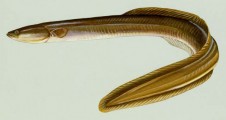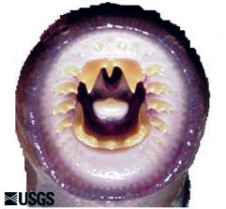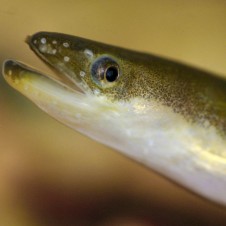Differences between a lamprey and an eel
When European settlers first saw the Pacific lamprey, they called them “eels” thinking they were the same food fish found throughout the eastern United States and Europe. Despite their similar body shape, the lamprey and eel are not even closely related (Lamprey are actually more closely related to hagfish and sharks). The name stuck, however, and it is common to still hear people call lamprey “eels.” Below is a table showing the attributes of both the lamprey and eels that highlights their differences.
Pacific Lamprey |
American Eel |
||
| Scientific classification | Kingdom: Animalia Phylum: Chordata Class: Cephalaspidomorphi Order: Petromyzontiformes Family: Petromyzontidae Genus: Entosphenus Species: E. tridentatus† |
Kingdom: Animalia Phylum: Chordata Class: Actinopterygii Order: Anguilliformes Family: Anguillidae Genus: Anguilla Species: A. rostrata |
|
| Appearance |
photo courtesy US Bureau of Reclamation |
photo courtesy Wisconsin Department of Natural Resources |
|
| Age of family | Approx. 450 million years old. | Approx. 5-7 million years old. (Same as salmon.) | |
| Physical description | A snake-like boneless body with a cartilage “skeleton,” open gill holes, a jawless sucking disc mouth, and no fin rays. Color ranges from dark blue to brown. Adults average about 1 lb. and 30” long. | A snake-like body with bones, a small pointed head, covered gill slits, weak jaws, many small teeth, and rayed fins. They are brown on the top and yellow on the bottom. Adults average about 4 lbs. and females: 5’, males: 3’ long. | |
| Mouth detail |
photo courtesy USGS |
photo courtesy DCNature |
|
| Reproduction and life history | Anadromous, like salmon. Adults lay as many as 200,000 pinhead-sized eggs in streambed nests, then die. After 2-3 weeks, tiny (as small as 3/16”), blind ammocoetes emerge and burrow into the muddy stream bottom to feed for 4-7 years. During a two-month metamorphosis, they develop eyes and a sucking disc; the 4-7” juveniles then migrate to the ocean where they feed and mature for 2-3 years before returning to freshwater to spawn. | Catadromous. Adults lay up to four million buoyant eggs that float on the ocean surface, then die. After 9-10 weeks, transparent eel larvae (called glass eels) hatch and drift with ocean currents, taking about a year to reach the Atlantic coast where they enter freshwater rivers and streams. Once in freshwater, they develop pigment and are called elvers. They feed and mature in freshwater for 10-14 years before returning to the ocean to spawn. They sometimes even cross wet grasslands on this migration. | |
| Feeding |
|
Carnivores feeding on insects, fish, fish eggs, crabs, worms, clams, frogs, and dead animal matter. | |
| Movement | Swim quickly, however has difficulty with high velocity and complex passage areas, which they navigate using burst speed punctuated by rests attached to hard surfaces. | Move equally well and forcefully forward and backward, giving them the ability to pull, twist and spin to tear apart large prey. | |
| Range | Baja California to the Bering Sea in Alaska and Asia. They are occasionally found as far west as Japan. | Along Atlantic coast and into associated rivers from Labrador to Gulf of Mexico, Caribbean, and southward. |
†the Pacific lamprey was formerly known as Lampetra tridentata.



